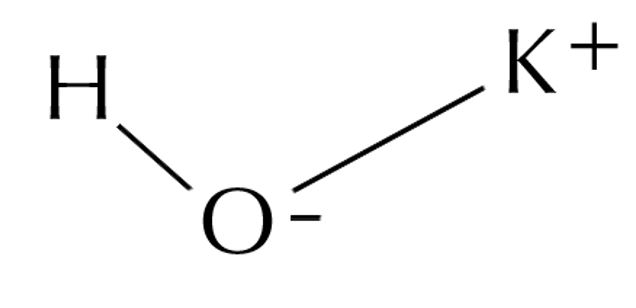Additional information
Brand
Caisson Labs
Product Storage Conditions
15 to 30°C
Product Shipping Conditions
Ambient - Dangerous Good
Product Attributes
| Format | |
|---|---|
| Size |

Potassium Hydroxide Formula (KOH) – CAS#1310-58-3; MW 56.11; HAZARDOUS MATERIAL – aka Caustic Potash.
Caisson Labs
15 to 30°C
Ambient - Dangerous Good
| Format | |
|---|---|
| Size |
A deliquescent solid that can efficiently absorb adequate moisture and carbon dioxide from the atmosphere. This inorganic base is also known as caustic potash [3].
INTRODUCTION
Structure
The molecular structure of potassium hydroxide is shown below.
 Figure 1: Structure of potassium hydroxide [6].
Figure 1: Structure of potassium hydroxide [6].
PROCEDURE
The standard procedure of proper preparation of potassium hydroxide commercially is described below in precise detail [1].
The economic production of pure potassium hydroxide occurred by typically using membrane cell technology that efficiently is less efficient energy utilizing and modern technology. This membrane cell is made up of the following components discussed below [2].
Figure 2:Manufacturing KOH using Membrane cell technology [1].
Preparation method:
2KCl + 2H2O ➔ Cl2 + H2 + 2KOH
SPECIFICATIONS
The specifications of potassium hydroxide are described below in the table [9] [10] [11].
| PROPERTIES | Potassium hydroxide |
|---|---|
| State | Solid |
| Appearance | Pallets, Powder or Flakes |
| Color | White |
| Odor | Odorless |
| Nature | Hygroscopic |
| Molecular formula | KOH |
| Molar Mass | 56.10 g/mol. |
| Exact mass | 55.96644614 |
| pH | Strongly alkaline |
| Vapor pressure | 1 mmHg ( 719 °C) |
| Heat of Fusion | 7.5 kJ/mole |
| Formal Charge | 0 |
| Solubility | Soluble in water |
| Solubility in water | 1120 g/L |
| Solubility in ethanol | Highly soluble |
| Density | 2.04 g/cm³ |
| Melting point | 361 degrees Celsius |
| Boiling point | 1320 degrees Celsius |
| Assay | ≥99.95% trace metals basis |
| CAS Number | 1310-58-3 |
| MDL Number | MFCD00003553 |
| PubChem ID | 14797 |
| InChl | 1S/K.H2O/h;1H2/q+1;/p-1 |
| InChl Key | KWYUFKZDYYNOTN-UHFFFAOYSA-M |
| SMILES | [OH-].[K+] |
APPLICATIONS
Caustic Potash realistically is a valuable chemical utilized in the largest volumes in industrial or commercial sectors. Following are some applications of potassium hydroxide that are described below [3] [4] [5].
SAFETY AND HAZARDS
Potassium hydroxide is a very corrosive and dangerous chemical. The safety and hazards are described below [1][3].
REFERENCES
| Product Lot Number: |